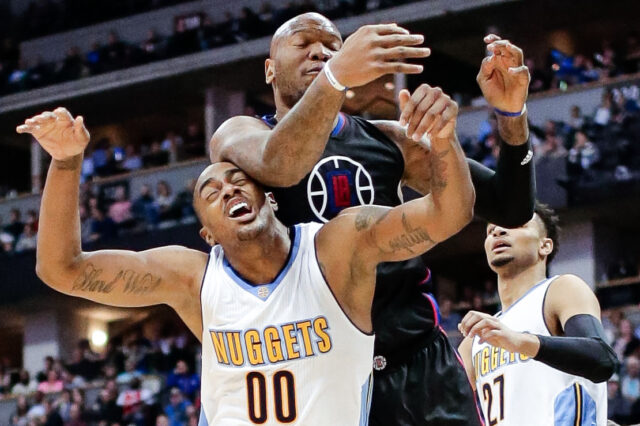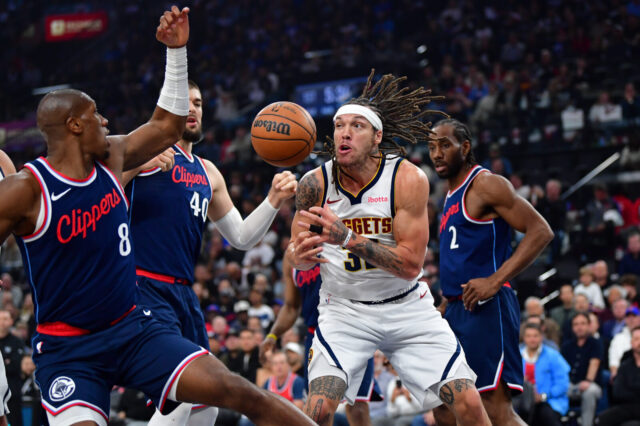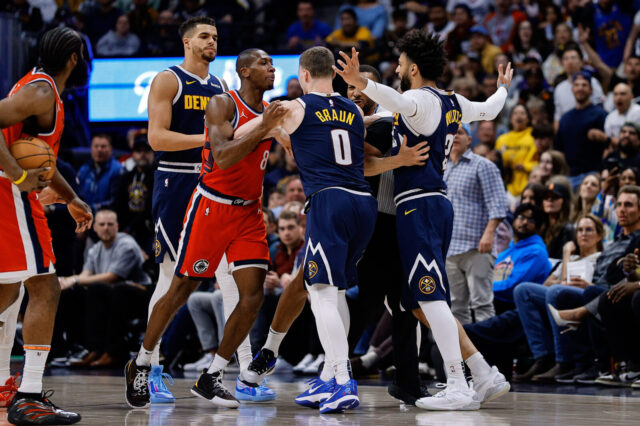If you’re not familiar with Film Fridays, each Friday, I’ll be looking at some recent Denver Nuggets’ games, lineups or something else from a film aspect to try and bring you a piece of content that you’re not getting somewhere else. Feel free to give any feedback positive or negative in the comments or find me on Twitter.
After one week of play, the Nuggets sit at 2-2, and they’re in the midst of a two-game losing streak. Nikola Jokic has maintained his high level of play thus far, and there have been flashes of strong play from guys like Will Barton and Aaron Gordon. One guy in particular that has struggled compared to expectations has been forward Michael Porter Jr. Fresh off of his recent contract extension, Porter has struggled to put the ball in the basket at the rate we had gotten used to seeing from him.
After averaging 19.0 points per game with a slashline of .542/.445/.791 last year, Porter is averaging just 11.5 points while shooting 34.6 percent from the field and 32.1 percent from 3-point range. Porter has shot greater than 50 percent in just one game this season, and he hasn’t shot greater than 30 percent since Game 1 of the year. Every player goes through rough patches, but this team needs his offense to sustain their winning ways until Jamal Murray is able to return from injury.
After being a knockdown shooter for the first two seasons of his career, what has happened? What can be done to fix it? That’s what we’re looking at today. When you give a guy a deal that’s going to have him see an average annual value north of $34 million per season, you have to make sure you’re doing everything you can to make sure he succeeds. Some of it comes down to his work also, but the sides have to work together to make them both successful.
Let Him Get Set
There’s a uniqueness to the way that Porter is able to get a shot off. He doesn’t have to be fully set when he releases it. His feet can be facing any which way, and it doesn’t matter what defenders are around him because he acts as if they’re not even there. However, there is a common theme with a lot of his misses from 3-point range. He’s often sliding around and moving and isn’t fully set. He can do that when he’s in a groove, but he’s often trying to rush up a shot while moving side-to-side or away from the rim when he’s struggling. On the shot above, he’s not fading away a ton, and there isn’t a lot of side-to-side movement. However, he is falling to his right which alters the entire shot trajectory. With his quick release, he doesn’t need a ton of space to get a shot off unlike other forwards at his height. Let him get set early in the game.
This shot is a good example of why a set Porter shot is so deadly. His release is extremely quick, so he doesn’t need a ton of separation to get the shot up cleanly. Throw in the fact that he has a high release, and he really just needs space to rise up to get a clear look. Monte Morris drives towards the basket in transition and finds Jeff Green at the top of the key. Green swings it to Porter, and Mike Conley is too far away to contest. Porter never has to reset his feet, and he rises up for the easy jumper. Porter is rarely going to get these clean looks with the amount of attention he gets, but the team needs to find ways to get him clean looks at the rim early in the game to let him see one shot fall. When one falls, they all start falling.
Get the Ball in his Hands
Ok, so hear me out for a second. I know I just said that Denver needs to get him more set shots, but that doesn’t mean he needs to be a statue. He needs to take some responsibility for not getting involved on offense when the play is designed for someone else. Since he came into the league, he’s had a tendency to stand off on his own when the play doesn’t involve him. There’s not an attempt at motion. He’ll stand and put up a shot if the ball ends up in his hands, but he’s not forcing the defender to stay attached to him. On the play above, Porter doesn’t do a lot of fancy dribbling or anything else. Instead, he takes advantage of the defender having to close out on him because of his shooting, and he gets into the paint for the layup. He’s not an elite ball-handler currently, but he should still get the ball in his hands to make plays rather than just being a spot-up shooter.
This clip is the perfect definition of shooting gravity. Porter has a defender right on his back out near the 3-point line. He makes a quick spin and is driving towards the paint. As he does this, the entire defense reacts to him, and he is able to draw not one but two help defenders. When that happens, it leaves Jokic wide open. Porter has never been a super willing passer when he’s operating off of the ball, but, on plays such as this when he’s the ball-handler, he looks to get others involved. Porter dumps it off to Jokic who converts the easy bucket. Porter isn’t your primary ball-handler, but you have to do more than just sit him off of the ball and treat him as a spot-up guy when he can make plays such as this one.
Play Him with the Second Unit
Denver’s second unit has been flat out bad this season. There is simply no way around it. On the team’s primary second unit of Jeff and JaMychal Green, Facundo Campazzo, P.J. Dozier and Austin Rivers, Jeff has the best offensive rating at 93.2. For reference, the league wide average is 107.0. What can help them? Getting Porter on the floor as a floor spacer that can also create his own shot and create for others. Looking at the play above, you can see Porter’s impact on the play despite the fact he never touches the ball. Barton is running an isolation play on the opposite side of the floor. When he starts his drive, Eric Paschall attempts to slide over to cut off the driving lane, but he’s so worried about Porter knocking down the kickout jumper that he has to slide back which gives Barton the lane to drive. The best players don’t always have to touch the ball to affect the game.
No one else on the floor for Denver in this situation can consistently create their own shot at the rate of Porter. Dozier can do something with the ball in his hands occasionally, but he’s far from consistent. Phoenix knows this, and Porter still ends up with the open jump shot. In this situation, Porter doesn’t have to feel obligated to get Jokic or Barton or anyone else involved in the play because it’s specifically designed for him. If you can’t figure out how to run plays for him with the starting lineup, put him in with your second unit that you’ve admitted struggles to score, and see what he can do with them.
For those of you that are still here, remember to leave your feedback in the comments or over on my Twitter, and have a fantastic film-filled Friday.


